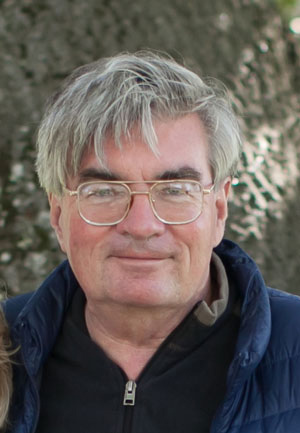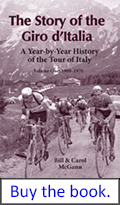

Wheel Building:
Part 5: Materials, Spokes explained
by John Neugent
Back to list of tech articles | Wheel building part 4
The late John Neugent probably knew more about bicycle wheels than anyone else. Maybe more about bikes as well. He spent his life in the bike business, at every level. He owned Neugent Cycling, a firm devoted to delivering world-class equipment at the lowest possible price. —Chairman Bill

John Neugent

Bill and Carol McGann's book The Story of the Giro d'Italia, A Year-by-Year History of the Tour of Italy, Vol 1: 1909 - 1970 is available as an audiobook here. For the print and Kindle eBook versions, just click on the Amazon link on the right.
John Neugent writes:
This is the final part of a multipart series:
The term we used for someone who wanted to know more than they needed was Spoke Sniffer. This article is for all of you Spoke Sniffers out there.
While it’s true you can get wheels with aluminum, titanium, or carbon spokes, the vast majority of quality wheels are made from stainless steel wire. I believe DT, Sapim, and Pillar all use 18/8 Sandvick wire—although each has their own special blend.
They are available in straight gauge, butted (multiple diameters) and bladed versions. Most quality spokes are either butted or bladed because they are lighter and stronger than straight gauge spokes. This additional strength is the result of forging the butted or bladed sections. The forging realigns the molecules to give them additional strength. The bladed spokes are typically stronger than the butted spokes because the blade is the result of an additional forging process over the butted spoke.

Spokes, a vital, high-tech part of a good wheel
Spoke threads are rolled and not tapped. Rolling results in a stronger and more precise thread.
Despite claims to the contrary, J bend and straight pull spokes are pretty much the same strength and it’s the spoke count and gauge that determine stiffness. In the old days spokes would normally break at the J bend but those days are long gone. After selling about 25,000 sets of wheels over the last 10 years I can count on the fingers of one hand the number of J bend spokes I have seen break at the bend.
Most spokes are 14 gauge (2.0 mm) which is the starting point before they are butted or bladed. Typical butted spokes are 2.0/1.8/2.0 or 2.0/1.7/2.0 or 2.0/1.5/2.0 – the differences being the thickness of the center section of the spoke. While that looks like splitting hairs, there is a good amount of weight savings to be had with the thinner center sections. A 2.0/1.8/2.0 spoke will typically weigh about 6 grams and its 2.0/1.5/2.0 cousin will be a tiny bit over 4 grams. Two grams a spoke times 44 spokes is 88 grams—with a corresponding increase in strength (the 1.5 mm center is forged more).
A similar weight savings can be had by using alloy nipples. Older alloy nipples were not as strong as brass nipples but with the introduction of 7000 series alloy nipples the differences are much less. It’s easier to round out an alloy nipple but that can be mitigated by using internal washers. Brass nipples are about 1 gram each while alloy are about .3 grams each. On a 44 spoke set of wheels that’s about 31 grams. The only time alloy nipples are a big liability is in high corrosion areas where they tend to corrode faster than brass.
So by using different spokes and alloy nipples it’s possible to save almost 120 grams on a 44 spoke wheel for very little additional cost and with a wheel that is equally strong or maybe even a little stronger.
Two other somewhat commonly used spoke gauges are 15 gauge (1.8 mm wire) and 13 gauge (2.34 mm). The 15 gauge wire is generally not used because you can achieve similar weights with butted 14 gauge. I have used 13 gauge spokes with some very good results. The spokes are incredibly strong and stiff because of the gauge but they are also heavy—about 9 grams. You can, however, use fewer spokes which means the wheels will be more aerodynamic.
In the US, the major brands are DT Swiss, Sapim, and to a lesser extent, Wheelsmith and Pillar.
DT Swiss was one of the first European spoke brands (they started making spokes about 100 years ago in Switzerland) to set up manufacturing in the US. Largely to supply Cannondale and Trek who, at the time, were doing all of their production in the US. Trek is still the major customer for DT in the US.
About the same time (in the early 80s I believe), Wheelsmith was also importing spokes from Asahi in Japan under their brand. Wheelsmith is the only other quality spoke maker currently manufacturing spokes in the US.
In the 90s, Sapim, a Belgian spoke maker, also got a foothold in the US largely due to the introduction of the CX Ray spoke—a thinly bladed aero spoke that fits through a conventional spoke hole. CX Ray spokes are now the choice of most quality US wheel makers because they are extremely light and strong. Most of the wheels on the Pro Tour use CX Ray spokes.
A relatively new entrant into the quality spoke market is Pillar. Also known as Sha Dar or Richman in Taiwan, the company decided to expand their spoke offerings from the mid and lower price points to the quality spoke market because, at the time, there were no quality spoke makers in Asia (DT has since set up production in Taiwan). When Mavic, Campagnolo, and many others began making quality wheels in Asia they were in need of a quality spoke maker and Pillar filled that gap.
All of the quality spoke makers now make very good spokes. While the quality from all of the best spoke makers is very high, it’s still possible to break an occasional spoke. I would recommend keeping one spoke of each length on hand for this eventuality. Typically you will need one length for the front wheel (two if disc brake) and two for the rear (one drive side and one non drive side). A good general rule of thumb is that if you break one spoke, replace it. If you break two, replace them all.
For the uneducated, spokes appear to be a very low tech product. But the opposite is true and the cost of the spokes on many wheels is often greater than the cost of the rim or hub. Luckily there are now many choices for quality spokes.
John Neugent was was one of the first to establish quality hand building in Taiwan around the turn of the century. He now owns Neugent Cycling, a firm devoted to delivering world-class equipment at the lowest possible price.
.







